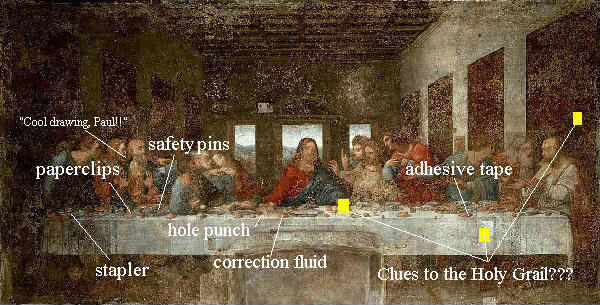The Da Vinci
Code
Leonardo da Vinci intently
studied the one hundred-year-old manuscript. It
had been the final writing of a fourteenth
century monk, Godalming of Guildford.
It had been Godalming’s
sacred task to copy the Holy Bible according to
papal instructions. One rule was that all copies
should be perfect. A simple slip of the quill
would necessitate burning the entire volume, even
if many thousands of words had already been
committed to parchment.
Godalming lamented the
destruction of many months of work due to a
simple error. He had thus experimented with
combinations of substances until he had perfected
what he named ‘correction fluid’. This,
when applied to an erroneous mark, would dry to
the same colour as parchment, leaving the mistake
invisible.
When news reached Rome, the
Pope pronounced this innovation to be the work of
the Devil. To hide error, rather than publicly
cleanse it in flame, was declared to strike at
the very heart of Christianity. Correction fluid
was forbidden and all supplies destroyed.
Godalming would have
merited no further attention had it not been for
his further ingenuity. He had experienced
problems in keeping completed pages together
while working on the next and was inspired to
invent the paperclip. The fact that pages of
sacred text could now be conjoined as if in
sexual congress enraged the Pope. Such a heinous
abomination could only have been devised by Satan
incarnate. He ordered Godalming put to death and
his evil devices erased from the face of the
Earth.
The manuscript that
Leonardo now carefully returned to its place of
concealment had been written shortly before the
Inquisition had burnt Godalming at the stake.
Safely hidden within the monastery for a century,
it had now, at enormous risk, been delivered to
Leonardo - leader of the secret brotherhood, Office
Dei.
The manuscript was the sole
text detailing ruthless Catholic suppression of
office supplies. Leonardo, however, knew
anecdotally of many incidents. A monastery in
northern France had been rased to the ground when
the use of adhesive tape had been discovered
within its walls. A legend from southern Germany
told of a heretical abomination of stationery so
perverted that the village from which it
emanated, with all its occupants, had been
obliterated by the Inquisition. Villages within a
fifty-mile radius had met the same fate. No clue
remained - except the name ‘postitnotes’.
Leonardo himself had been
secretly guilty of the sin of designing office
equipment, including a stapling device and a
ballpoint quill. He recalled the tense moment
when the Inquisition had discovered the drawings.
To his great relief they had accepted his
explanation that these were parts of a flying
machine to allow the Pope to journey closer to
God.
Members of Office Dei
swore a sacred oath to pass their arcane
knowledge to future generations and to quest for
the meaning of ‘postitnotes’ –
‘The Holy Grail’ in the coded language
of their brotherhood.
Such were Leonardo’s
thoughts as he continued his depiction of The
Last Office Party.
He portrayed key aspects of
the biblical text such as Paul, in the absence of
a photocopier, exhibiting drawings of his bum
made by a scribe. In addition, however, he subtly
included images of office supplies.
Legend tells how the yellow
squares may even be clues to the Grail itself!

The Last Office Party
by
Leonardo da Vinci
|